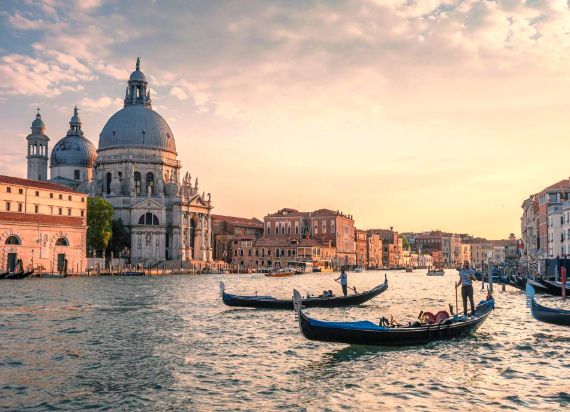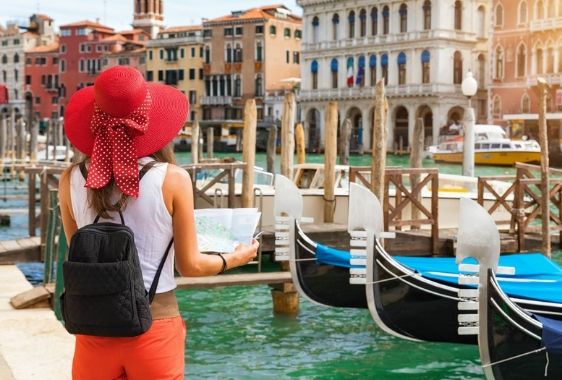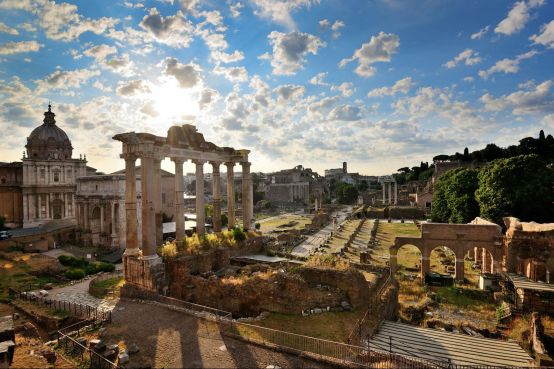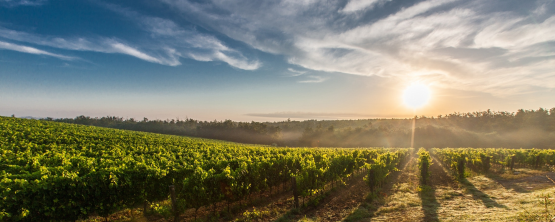Lake Garda located in the region of Veneto in north-east Italy and is the largest of Italy's fresh-water lakes. Lake Garda is some 30 miles long and ranges from 1 - 10 miles wide throughout its length, and is over 350m in depth in certain areas.
Lake Garda is also probably the cleanest of Italy's great lakes, probably the only one left at where you can still swim in its waters. Although its cool mountain air that drifts down from the Alps makes swimming only plausible in high summer when the temperatures can soar to 35° C.
Visitors to Lake Garda will find many things to see and do both at the Lake itself and the neighbouring countryside. The landscape that surrounds the Lake varies from the southern tip of Garda that embraces the plains of Veneto and the soft undulating hills of the Bardolino wine region one of the many DOC registered wine growing regions of the Veneto. This red wine is growing in reputation on annual basis, and while visiting the town of Bardolino on the lakeshore you can take a short drive up in to the hills at the back of town to visit an Enoteca established by the local wine growers where you can taste the celebrated wine.
The most famous town on the Lake is Sirmione which is home to the "Rocca Scaligiera" castle which is one of the main attractions of the Lake. Built by the Scaligieri who were warlords of Verona, and who during their time prior to the Venetian conquest of the mainland ruled most of modern-day Veneto. Enjoying a strategic position on the Lake, it was captured by the Milanese in the 15th Century.
The Venetians retaliated with one of the most imaginative and incredible manoeuvres to recapture the fortress. Instead of committing themselves to a head-on assault coming across the Venetian plains to the castle, they dragged their ships across the top of the mountains to enter Lake Garda from the north. Taking the Milanese completely by surprise, they recaptured the castle.
Sirmione is probably the main destination for tourists visiting Lake Garda, and on the southern tip of the Lake there are too many campsites and with the "Gardaland" water theme park avoid this area in the summer months, as traffic can be horrendous.
Lake Garda has several ferries operating along its shores and from one side of the lake to the other, and in may cases especially in high summer or during holiday weekends its best to travel via the water than by land. The roads that ring Lake Garda are narrow and winding and are ill-prepared to handle the onslaught of visitors especially coming from Austria & Germany.
The further north you go on Lake Garda the more spectacular the scenery becomes. After exploring the delightful town of Malcesine that boasts another 14th Century Scalagieri castle you could take a 5-minute cable-car ride to the top of Mt. Baldo to enjoy an incredible panorama at a height of 1850 m.
On the northern side of Lake Garda you'll find the principal town of Riva del Garda which was a strategic town for the Venetian republic back in the 15th Century. From Riva you can visit the Varone waterfalls located a couple of miles outside of town and some 295m high. Torbole, a 10-minute boat ride from Riva, is a quaint little lakeside that offers a break from the bigger resorts overrun by tourists. In the hills above town, you'll find many beautiful hikes, and in fact throughout the course of Lake Garda there are numerous hiking trails to suit walkers of all abilities.
The town of Salo on the western shores of Lake Garda has a more recent and infamous role in the history of Italy. A place where Mussolini retreated to as he fell from grace, and where he was presumed to have been executed by the partisans.
The town also boasts a marvellous mansion cum museum, once owned by Mussolini's friend and famous Italian writer D'Annuzio. The museum houses all the personal collections of the famous writer including some perculiar tastes in slippers and phallic symbols. Salo is also an ideal place to take a dip in the Lake. In 2005, Salo again hit the headlines for the wrong reason as an earthquake that struck Lake Garda left many people homeless in the town.
In-between the principal towns that line the Lake Shore there are many more smaller communities to visit and places to pause for idyllic views, delightful restaurants and peaceful hamlets. And close by to Lake Garda you have the delightful hills of the Valpolicella wine region to explore that are home to the famous Amarone wine, "the big dry one".
A 30-minute drive from Lake Garda is the city of Verona, home of Romeo & Juliet, and the Verona Arena that hosts the famous Opera season. Further a field there are the beautiful Dolomite mountain range to explore on day or overnight trips, and at Bolzano north of Lake Garda we can't forget the remains of the "Iceman". Typical of Italy, Lake Garda has more than enough to satisfy the visiting tourist and the above information should help you plan your up and coming trip to Lake Garda.
Weather at Lake Garda
Lake Garda is located in north-east Italy, bordered on the south by the plains of the Veneto which seem to invite in the summer months the warm winds originating from Africa & the Sahara. Its northern shore faces onto the Dolomites & South Tyrol and the valleys carved by previous glaciers in the winter act like wind tunnels bringing down the cold winter air in the form of heavy winds that can make the waters of Lake Garda rise up like the waters of an open sea.
The economy of Lake Garda apart from the production of Wine, fine cheeses and fledgling artisan workshops is more or less tourism. In the winter everything closes down and its not an ideal time to visit the lake. The best times to visit are the Spring & Fall months when the climate is ideal, the clear blue skies create the ideal visibility and the flora of Lake Garda is at its best. Apart from holiday weekends you'll find Garda relatively tranquil and this time of year is the ideal time to venture off-the-well-beaten path to hike and walk amongst the hills and mountains that surround the Lake.
In the summer months, the climate of Lake Garda can be very hot and humid, and often these months the high pressure of southern air clashing with the colder mountain air can create thunderstorms on a regular basis. Also, the roads around the Lake can be overrun with Italian and German tourists making it hard going for the tourist looking for a relaxing vacation. If you visit during the summer months try to utilize water transport to get around the lake to avoid delays in traffic and plan to stay on the northern side of the Lake Garda, as the southern shores of the Lake are easily accessible from nearby Italian cities via the main highway that runs between Venice & Milan.
Tourist Offices at Lake Garda
Main Tourist Office
Viale Marconi, 8
Sirmione, Lake Garda
Telephone: +39 030 - 3748721
Other tourist offices at Lake Garda that provide free maps and information for tourists include: Malcesine Tourist Office, Via Gardesana, 238 (tel: +39 045 7400044); Riva Del Garda, Largo Medaglie d'Oro al Valor Militare, 5 ( tel: +39 0464 554444).
How to get to Lake Garda
Special Transfer- Tours
Along with straight transfers between Lake Garda & other destination or arrival points in Italy, we also arrange special transfer-tours that enable our guests to make the most of their time in Italy through which we arrange transfers that combine tours of cities or places en route to your final destination. Someone transferring between Venice & Lake Garda could pause along the way to enjoy a guided tour of Verona, or perhaps enjoy lunch and a wine-tasting in the Valpolicella wine region. Conatct us for more details on how we can customize your vacation.
By Car
Access to Lake Garda is quite simple utilizing the A4 Autostrada (highway) that runs between Venice & Milan you would exit at Peschiera. The journey would take approximately 90-minutes travelling form Venice and a similar time and distance from Milan to arrive at the Southern tip of the Lake. Depending on the time of the year, particularly during the summer months, if you're heading to the northern side of the Lake you might want to follow indications for Brenna and take the highway north to the exit for Riva del Garda. For those staying in nearby Verona, a scenic drive by car to Lake Garda would be following the Valpolicella wine road through the vineyards and just after St. Ambrosia you can connect with Lake Garda passing through the hills and vineyards of the Bardolino wine region. To circumnavigate the lake you need to take S572 road to drive along the western and southern shores of Lake Garda, and the S45b for the opposite sides of the Lake.
By Train
There is a frequent train service to Lake Garda as it lies on the main Milan to Venice rail-line, approximately one and a half hours from both Venice & Milan by rail, and 20-minutes from Verona the station serving Lake Garda is the Desenzano del Garda - Sirmione station. Pretty much the trains operate every hour of the day from 8 a.m. until 9 p.m. If you are planning to reach Lake Garda from northern Europe you can change trains at Verona and make the quick connection to Lake Garda.
By Air
The nearest airport to Lake Garda is either the smaller Verona or Brescia international airports that are well-served by low-cost airlines like RyanAir and EasyJet making Lake Garda a convenient destination for a weekend break. For people coming form further a field the nearest major airports are located at Venice or Milan for which you would have to transfer to main-line railway stations at the respective cities to arrive at Garda, or hire a car or perhaps consider taking one of our custom transfer-tours to your final destination.













